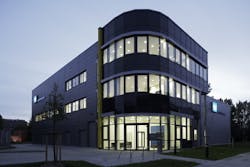Jenoptik opens new production site for high-power lasers
Berlin, Germany -- Jenoptik's Lasers & Materials Processing division has opened its new production facility for semiconductor lasers in the Berlin-Adlershof Technology Park. The €10 million investment in the site will more than double production capacities, and is the largest to date for the optoelectronics group after a site for energy systems in Altenstadt (Bavaria) was modernized and expanded in 2011.
The expanded facility, for which the company laid the foundation stone in December 2011, will begin operations at the start of 2013. The site develops and manufactures semiconductor lasers, "laser bars," used as a base material for high-power diode lasers. The expansion is intended to meet strong growth in demand particularly from Asia.
Jenoptik's Berlin-Adlershof site, built during 2005-2006 with 2000 sq. m., is near the Ferdinand-Braun-Institut, Leibniz-Institut für Höchstfrequenztechnik (FBH) (Institute for Ultra High Frequency), a longtime partner in development of the optoelectronic base material for diode lasers. Their collaboration won the WissensWerte Transfer Prize in March of this year, which included €50,000 to further develop highly efficient diode lasers. In 2008 Jenoptik acquired local firm Three-Five Epitaxial Services Aktiengesellschaft (TESAG), itself a spinoff from the FBH, which added epitaxial wafer manufacturing.
Including the current expansion, Jenoptik has invested more than €25M in production at the Berlin-Adlershof site since 2005. The current expansion has increased the size of the facility from the original 2,000 to 3,400 sq. m today, with almost 1,000 sq. m of clean room space that includes the entire process line for epitaxy, wafer processing, and facet coating to manufacture semiconductor lasers. Laser bars from the Berlin site are supplied to customers throughout the world, and at Jenoptik's site in Jena are processed to make high-power diode lasers and integrated into other laser systems.
Demand for high-power diode lasers has risen sharply over recent years as a result of new laser applications, notes Jenoptik. In the area of industrial laser materials processing, diode lasers are used as a high-efficiency pumping source for solid-state and fiber lasers or increasingly as a direct application ("diode direct"), amongst other things for soldering and hardening of metals as well as for welding plastics.
Jenoptik's sales with the base material for high-power diode lasers have tripled since 2006, noted company chairman Michael Mertin. The company plans to invest approximately €35M in 2012.
Jenoptik's diode lab building in Berlin. (Source: Jenoptik)
About the Author

James Montgomery
Associate Editor
James manages editorial production for news (online and print) and newsletters, as well as the magazines' new product sections. Jim has 13 years’ experience in producing Web sites and e-mail newsletters in various technology markets for CNet, ZDNet, Digital City Boston/AOL, and KM World.

